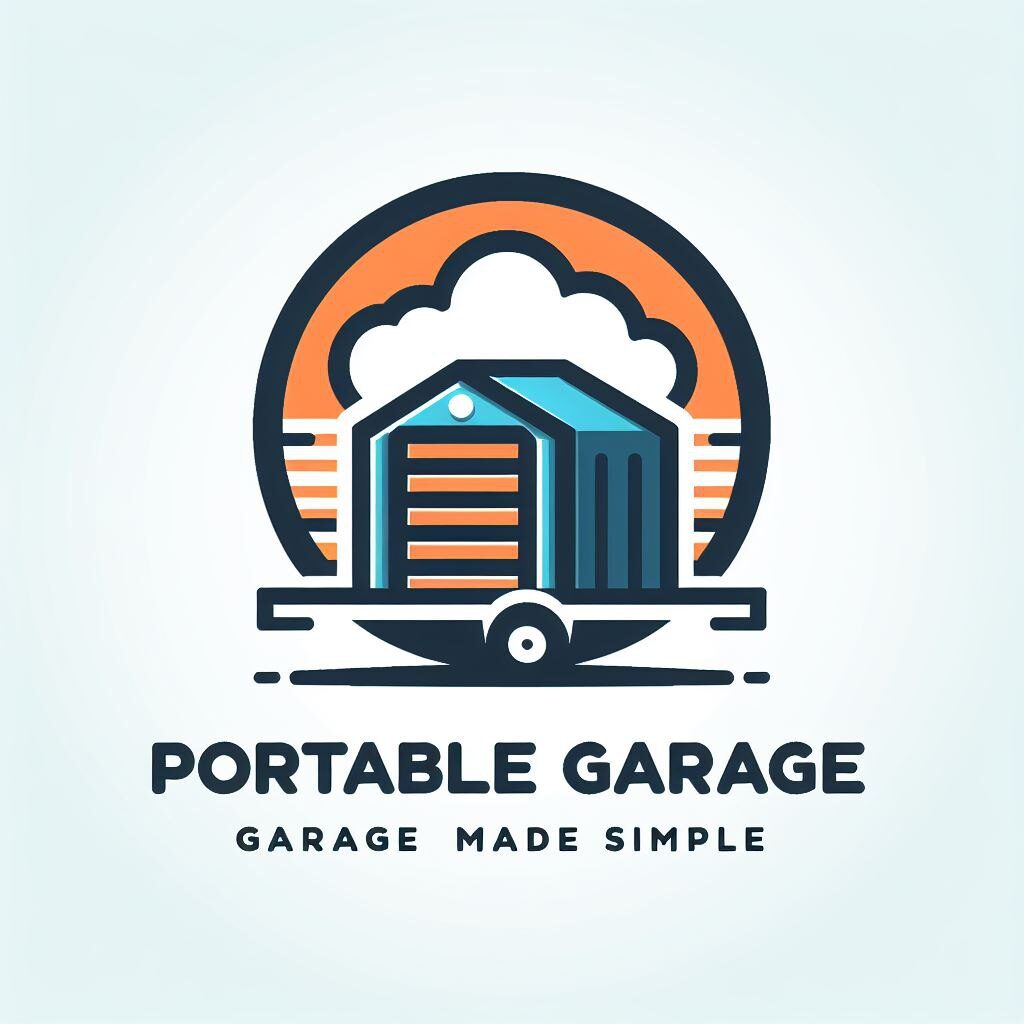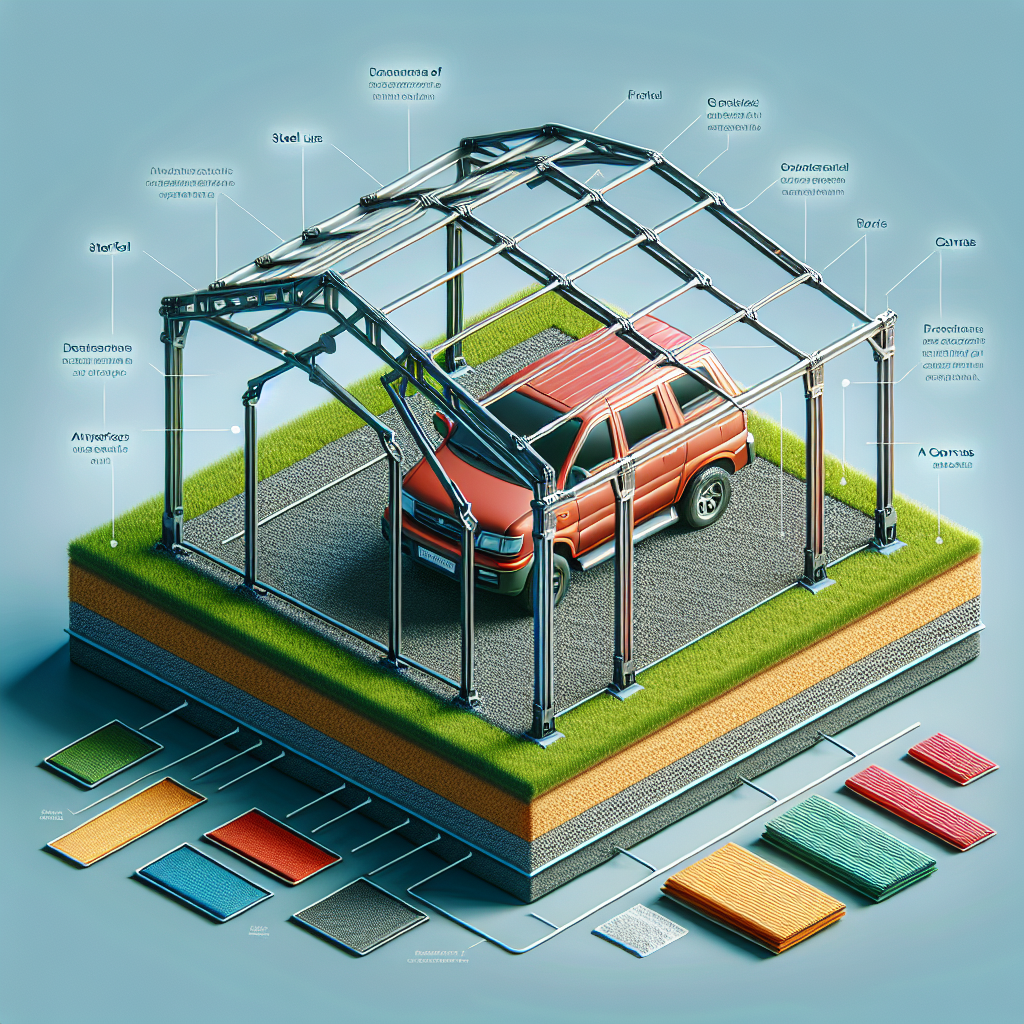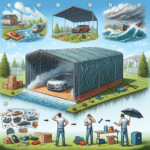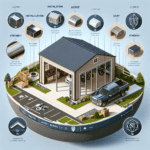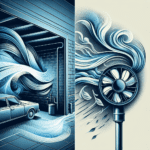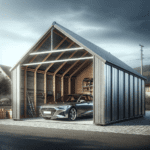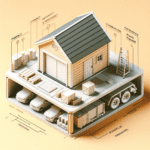portable garages are an excellent solution for those in need of practical and convenient storage spaces for their vehicles. But have you ever wondered what materials go into constructing these handy shelters? In this article, we will explore the common materials used for portable garages, shedding light on their durability, versatility, and overall functionality. Whether you’re a car enthusiast or simply looking to protect your vehicle from the elements, understanding the materials that make up portable garages is key to making an informed decision. So, let’s dive into the world of portable garage materials and discover which ones best suit your needs.
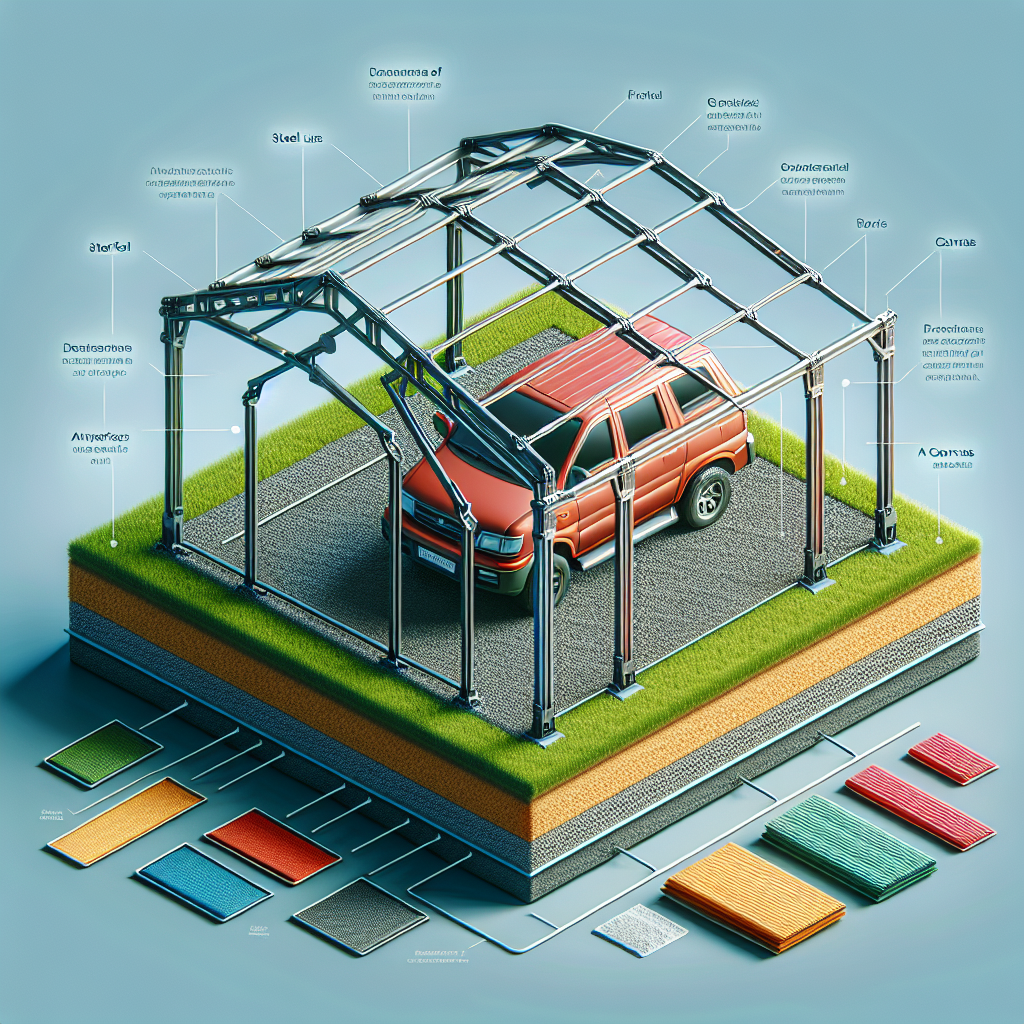
Wood
Wood is a popular material used for constructing portable garages, and it comes with its own set of advantages and disadvantages.
Advantages of Wood
One of the major advantages of using wood for portable garages is its natural beauty. Wood has a warm and rustic aesthetic that adds charm to any outdoor space. It blends well with natural surroundings and can enhance the overall appeal of your property.
Wood is also a renewable resource, making it an environmentally friendly choice. By choosing wood for your portable garage, you contribute to the sustainable management of forests.
In terms of durability, wood can withstand a fair amount of wear and tear. With proper maintenance and treatment, it can last for many years. It also provides good insulation, helping to keep the interior of the garage cool in summer and warm in winter.
Another advantage of wood is its versatility. It can easily be customized and shaped to fit any design or size requirements. Whether you need a small portable garage or a larger one with additional storage space, wood can be easily adapted to your needs.
Disadvantages of Wood
Despite its numerous advantages, wood also has some drawbacks. One of the primary concerns with wood is its susceptibility to moisture and pests. If not properly treated and maintained, wood can rot, warp, or be attacked by termites, which can significantly reduce its lifespan.
Wood is also prone to fire, which can be a safety concern. However, using fire-resistant treatments and taking necessary precautions can help mitigate this risk.
Additionally, wood requires regular upkeep. It needs to be stained, painted, or sealed to protect it from the elements. This maintenance can be time-consuming and may involve additional costs.
Metal
Metal is another popular material choice for portable garages, offering its own unique advantages and disadvantages.
Advantages of Metal
One of the significant advantages of using metal for portable garages is its strength and durability. Metal structures are known for their ability to withstand harsh weather conditions, such as heavy snow loads, high winds, and even earthquakes. This makes metal garages a reliable and long-lasting option.
Metal is also fire-resistant, which adds an extra level of safety for both your belongings and your property. Unlike wood, metal does not provide fuel for a fire, reducing the risk of damage in case of an unexpected event.
Additionally, metal garages are relatively low maintenance. They do not require regular painting or sealing, saving you time and money in the long run. Metal is also resistant to pests and is not susceptible to rotting or warping, further extending its lifespan.
Another advantage of metal is its versatility in design and size. Metal structures can be easily customized to meet your specific requirements and can be easily expanded or modified as your needs change over time.
Disadvantages of Metal
Despite its numerous benefits, metal also has a few disadvantages to consider. One of the main concerns with metal is its heat conductivity. Metal garages can become hot during the summer months, making the interior uncomfortable. However, proper insulation can help mitigate this issue.
Metal structures can also be more expensive initially compared to some other materials. However, considering their long-term durability and minimal maintenance requirements, they can be a cost-effective investment in the long run.
Lastly, metal garages can be noisy during heavy rainfall or hailstorms, as the raindrops can create a loud drumming sound on the metal surface. However, this can be minimized by adding insulation or using noise-dampening materials during construction.
Vinyl
Vinyl is a versatile and popular material choice for portable garages, offering its own unique advantages and disadvantages.
Advantages of Vinyl
One of the primary advantages of using vinyl for portable garages is its durability. Vinyl structures are highly resistant to moisture, rot, and pests. Unlike wood or metal, vinyl does not require regular maintenance such as sealing or painting. This makes vinyl garages a low-maintenance option that can save both time and money.
Vinyl also provides excellent protection against UV rays, which can cause fading and damage to vehicles and other belongings stored in the garage. By choosing vinyl, you can ensure that your items are protected and maintain their appearance.
Another advantage of vinyl is its lightweight nature, making it easy to transport and assemble. Vinyl portable garages are typically designed with interlocking panels or frames, allowing for quick and hassle-free installation. This makes them a convenient option for those who frequently move or need a temporary storage solution.
In terms of aesthetics, vinyl garages come in a variety of colors and styles, allowing you to choose a design that complements your property. Vinyl’s sleek and modern look can enhance the appearance of your outdoor space while providing functional storage.
Disadvantages of Vinyl
Despite its benefits, vinyl also has some disadvantages to consider. One of the main concerns with vinyl is its susceptibility to extreme weather conditions. In areas with high winds or heavy snow, vinyl structures may not be as durable as metal or wood. While they can still withstand moderate weather, it is important to consider the specific climate in your area before choosing vinyl for your portable garage.
Another disadvantage of vinyl is its limited structural strength compared to metal or wood. Vinyl garages may not be suitable for heavy-duty storage or for areas with stringent building code requirements. However, for basic storage needs and moderate weather conditions, vinyl can be a practical and cost-effective option.
Lastly, vinyl garages may not have the same level of insulation as wood or metal structures. While they provide adequate protection against the elements, they may not offer the same level of temperature control. This can be a consideration if you plan to use the garage for purposes other than basic storage.
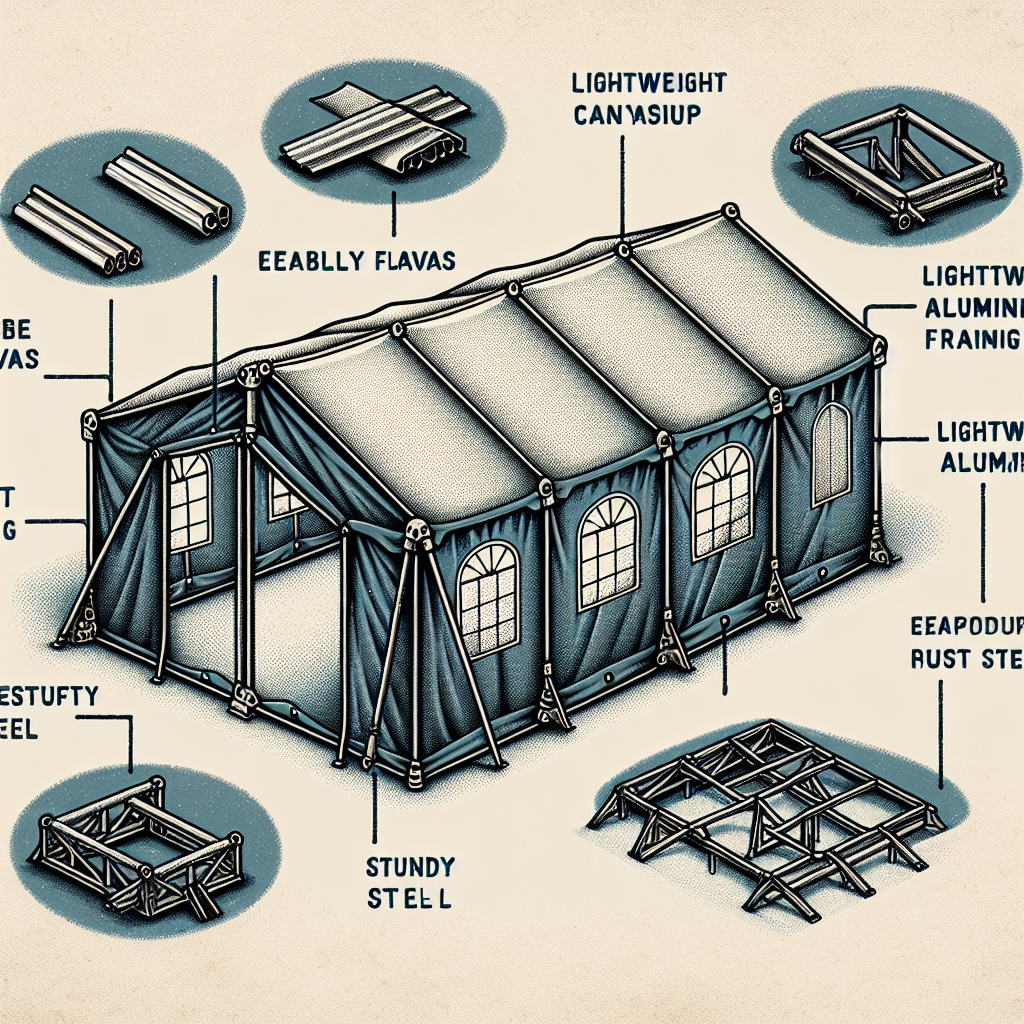
Polyethylene
Polyethylene is a versatile material choice for portable garages, offering its own unique advantages and disadvantages.
Advantages of Polyethylene
One of the primary advantages of using polyethylene for portable garages is its lightweight nature. Polyethylene structures are easy to transport and assemble, making them a convenient option for those who frequently move or need a temporary storage solution. The lightweight design also allows for quick and hassle-free installation.
Polyethylene is also highly resistant to moisture, rot, and pests, making it a low-maintenance option. Unlike wood or metal, polyethylene does not require regular maintenance such as sealing or painting. This saves both time and money and ensures that your garage remains in good condition for years to come.
Another advantage of polyethylene is its affordability. It is often a cost-effective alternative to other materials, making it an attractive option for those on a budget. Despite its lower price point, polyethylene structures still provide adequate protection and storage space.
Polyethylene garages also offer good UV protection, preventing fading and damage to vehicles and other belongings stored inside. This helps to maintain the appearance and value of your belongings over time.
Disadvantages of Polyethylene
While polyethylene has its advantages, it also has some disadvantages to consider. One of the main concerns with polyethylene is its vulnerability to extreme weather conditions. It may not be as durable as other materials, such as metal or wood, in areas with high winds or heavy snow loads. It is important to evaluate the specific climate in your area before choosing polyethylene for your portable garage.
Polyethylene structures may also have limited longevity compared to other materials. Over time, the fabric or material may degrade or become discolored due to exposure to sunlight and weather conditions. This may necessitate replacement or additional maintenance to ensure the garage remains in good condition.
Furthermore, polyethylene garages may not have the same level of insulation as other materials. While they provide protection against the elements, they may not offer the same level of temperature control. This may be a consideration if you plan to use the garage for purposes beyond basic storage.
Canvas
Canvas is a versatile material choice for portable garages, offering its own unique advantages and disadvantages.
Advantages of Canvas
One of the primary advantages of using canvas for portable garages is its lightweight and portable nature. Canvas structures are easy to transport and assemble, making them a convenient option for those who frequently move or need a flexible storage solution. The lightweight design allows for quick and hassle-free installation, making canvas garages suitable for temporary storage needs.
Canvas is also an affordable material option, making it an attractive choice for those on a budget. Despite its lower price point, canvas garages can provide adequate protection and storage space for your belongings.
Canvas structures offer good UV protection, preventing fading and damage to vehicles and other items stored inside. The fabric acts as a barrier against harmful UV rays, helping to maintain the appearance and value of your belongings over time.
Additionally, canvas garages are highly customizable. They come in various sizes, styles, and colors, allowing you to choose a design that suits your preferences and complements your outdoor space. This versatility makes canvas a popular choice for those who want a personalized storage solution.
Disadvantages of Canvas
While canvas has its advantages, it also has some disadvantages to consider. One of the main concerns with canvas is its vulnerability to extreme weather conditions. Canvas structures may not be as durable as materials like metal or wood in areas with high winds or heavy snow loads. It is important to evaluate the specific climate in your area before opting for a canvas portable garage.
Canvas garages may also require more regular maintenance compared to other materials. The fabric needs to be properly cleaned and treated to prevent mold, mildew, or water damage. This ongoing maintenance adds to the overall cost and time investment.
Furthermore, canvas garages may have limited longevity compared to other materials. Over time, the fabric may degrade or become discolored due to exposure to sunlight and weather conditions. This may require replacement or additional maintenance to ensure the garage remains in good condition.
Lastly, canvas garages may not provide the same level of insulation as other materials. While they provide protection against the elements, they may not offer the same level of temperature control. This may be a consideration if you plan to use the garage for purposes beyond basic storage.
Aluminum
Aluminum is a versatile material choice for portable garages, offering its own unique advantages and disadvantages.
Advantages of Aluminum
One of the primary advantages of using aluminum for portable garages is its lightweight nature, making it easy to transport and assemble. Aluminum structures are typically designed with interlocking panels or frames, allowing for quick and hassle-free installation. This makes them a convenient option for those who frequently move or need a temporary storage solution.
Aluminum is also highly resistant to rust and corrosion, making it a durable choice for outdoor structures. It withstands exposure to the elements without deteriorating, ensuring that your garage remains in good condition for many years.
Another advantage of aluminum is its low maintenance requirements. Unlike wood or some other metals, aluminum does not require regular painting or sealing. This saves you time and money in the long run.
In terms of design, aluminum garages offer versatility. They can be customized to meet specific size and design requirements, making them suitable for various storage needs. Whether you need a small garage or a larger one with additional storage space, aluminum can be easily adapted to your needs.
Disadvantages of Aluminum
Despite its advantages, aluminum also has some disadvantages to consider. One of the main concerns with aluminum is its relatively low structural strength compared to other metals such as steel. While suitable for most storage needs, aluminum garages may not be as suitable for heavy-duty storage or for areas with rigorous building code requirements.
Aluminum structures may also be more expensive initially compared to other materials. However, considering their long-term durability and minimal maintenance requirements, they can be a cost-effective investment over time.
Additionally, aluminum garages may not have the same level of insulation as some other materials. While they provide adequate protection against the elements, they may not offer the same level of temperature control. This may be a consideration if you plan to use the garage for purposes beyond basic storage.
Steel
Steel is a popular material choice for portable garages, offering its own unique advantages and disadvantages.
Advantages of Steel
One of the primary advantages of using steel for portable garages is its strength and durability. Steel structures are known for their ability to withstand harsh weather conditions, such as heavy snow loads, high winds, and even earthquakes. This makes steel garages a reliable and long-lasting option.
Steel is also highly resistant to pests, rot, and fire, offering excellent protection for your belongings. Unlike wood or vinyl, steel does not provide food for pests or fuel for a fire, reducing the risk of damage. This added level of safety is particularly important when storing valuable items or vehicles.
Furthermore, steel garages are low maintenance. They do not require regular painting or sealing, saving you time and money in the long run. Steel is also resistant to rust and corrosion, ensuring that your garage remains in good condition for many years.
In terms of design, steel garages offer versatility and can be customized to meet specific size and design requirements. Whether you need a basic storage space or a garage with additional features like windows or doors, steel can be easily adapted to your needs.
Disadvantages of Steel
Despite its numerous benefits, steel also has some disadvantages to consider. One of the main concerns with steel is its heavyweight nature, making it less portable compared to other materials. Steel garages may require professional installation and cannot be easily disassembled or moved.
Steel structures may also be more expensive initially compared to other materials. However, considering their long-term durability and minimal maintenance requirements, they can be a cost-effective investment over time.
Additionally, steel garages can be prone to condensation. The temperature differential between the interior and exterior of the garage can cause moisture to form inside, potentially leading to rust or corrosion. Proper insulation and ventilation can help mitigate this issue.
Lastly, steel garages may not offer the same level of insulation as some other materials. While they provide adequate protection against the elements, they may not offer the same level of temperature control. This may be a consideration if you plan to use the garage for purposes beyond basic storage.
Fiberglass
Fiberglass is a versatile material choice for portable garages, offering its own unique advantages and disadvantages.
Advantages of Fiberglass
One of the primary advantages of using fiberglass for portable garages is its lightweight nature. Fiberglass structures are easy to transport and assemble, making them a convenient option for those who frequently move or need a temporary storage solution. The lightweight design allows for quick and hassle-free installation.
Fiberglass is also highly resistant to moisture, rot, and pests, making it a low-maintenance option. It does not require regular maintenance such as sealing or painting, saving both time and money. The resistance to pests is particularly advantageous, as it reduces the risk of damage to your belongings.
Fiberglass structures offer excellent insulation properties, helping to maintain a comfortable temperature inside the garage. This can be especially beneficial if you plan to use the garage for purposes other than basic storage, such as a workshop or hobby space.
Additionally, fiberglass garages are highly customizable. They come in various sizes, styles, and colors, allowing you to choose a design that suits your preferences and complements your outdoor space. This versatility makes fiberglass a popular choice for those who want a personalized storage solution.
Disadvantages of Fiberglass
While fiberglass has its advantages, it also has some disadvantages to consider. One of the main concerns with fiberglass is its vulnerability to extreme weather conditions. It may not be as durable as other materials, such as metal or wood, in areas with high winds or heavy snow loads. It is important to evaluate the specific climate in your area before opting for a fiberglass portable garage.
Fiberglass garages may also have limited longevity compared to other materials. Over time, the fiberglass panels may become brittle or discolored due to exposure to sunlight and weather conditions. This may necessitate replacement or additional maintenance to ensure the garage remains in good condition.
Furthermore, fiberglass garages may not provide the same level of security as other materials. While they provide protection against the elements, they may not offer the same level of durability against forced entry. This may be a consideration if you plan to store valuable items or vehicles in the garage.
Lastly, fiberglass garages may have a higher initial cost compared to some other materials. However, considering their long-term durability and insulation properties, they can be a worthwhile investment.
PVC
PVC, or polyvinyl chloride, is a versatile material choice for portable garages, offering its own unique advantages and disadvantages.
Advantages of PVC
One of the primary advantages of using PVC for portable garages is its lightweight nature. PVC structures are easy to transport and assemble, making them a convenient option for those who frequently move or need a temporary storage solution. The lightweight design allows for quick and hassle-free installation.
PVC is also highly resistant to moisture, rot, and pests, making it a low-maintenance option. It does not require regular maintenance such as sealing or painting, saving both time and money. The resistance to pests is particularly advantageous, as it reduces the risk of damage to your belongings.
Furthermore, PVC garages offer good UV protection, preventing fading and damage to vehicles and other stored items. The material acts as a barrier against harmful UV rays, helping to maintain the appearance and value of your belongings over time.
In terms of design, PVC garages are highly customizable. They come in various sizes, styles, and colors, allowing you to choose a design that suits your preferences and complements your outdoor space. This versatility makes PVC a popular choice for those who want a personalized storage solution.
Disadvantages of PVC
While PVC has its advantages, it also has some disadvantages to consider. One of the main concerns with PVC is its vulnerability to extreme weather conditions. It may not be as durable as other materials, such as metal or wood, in areas with high winds or heavy snow loads. It is important to evaluate the specific climate in your area before opting for a PVC portable garage.
PVC garages may also have limited longevity compared to other materials. Over time, the PVC panels may become brittle or discolored due to exposure to sunlight and weather conditions. This may necessitate replacement or additional maintenance to ensure the garage remains in good condition.
Furthermore, PVC garages may not provide the same level of insulation as other materials. While they provide protection against the elements, they may not offer the same level of temperature control. This may be a consideration if you plan to use the garage for purposes beyond basic storage.
Lastly, PVC garages may have a higher initial cost compared to some other materials. However, considering their lightweight nature and low-maintenance requirements, they can still be a cost-effective choice for many.
Conclusion
When it comes to choosing a material for your portable garage, there are numerous options available, each with its own advantages and disadvantages. Wood offers natural beauty and versatility but requires regular maintenance and may be prone to moisture and pest-related issues. Metal provides exceptional strength and durability but may be more expensive and can be noisier during heavy rain. Vinyl and polyethylene offer low-maintenance options with good UV protection, but both may not be as durable in extreme weather conditions. Canvas is a lightweight and affordable choice, but it requires more regular maintenance and may have limited longevity. Aluminum and steel are robust options with low maintenance requirements, but aluminum may not have the same structural strength, and steel may be heavier and less portable. Fiberglass offers good insulation and customization options, but it may not be as durable or secure. Lastly, PVC is lightweight and easy to assemble but may not be as durable or insulating as other materials.
Consider your specific needs, budget, and the climate in your area when making a decision. By carefully weighing the advantages and disadvantages of each material, you can choose a portable garage that meets your requirements and provides a safe and functional space for your belongings.
